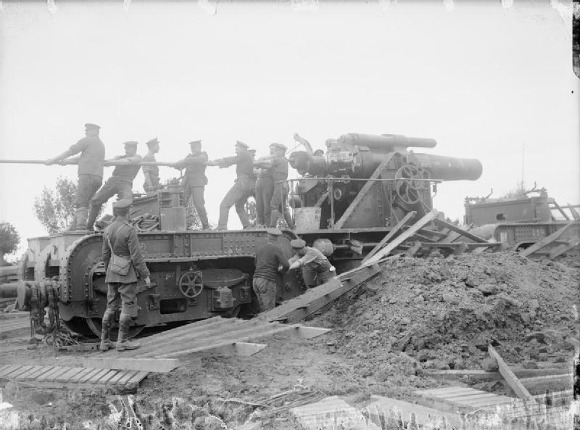Wilfred Owen, selected poems Contents
Sonnet on Seeing a Piece of Our Heavy Artillery Brought into Action - Synopsis and commentary
Synopsis of Sonnet On Seeing a Piece of Our Heavy Artillery Brought into Action
 In this sonnet Owen addresses a ‘Great Gun’ which is being installed on the Western front in order to bombard the German line. At first Owen orders the gun to do its work, to curse the enemy before they do further harm. However, in the second stanza the poet asks that the militaristic, aggressive spirit which the gun symbolises is not incorporated into peacetime life, but that God will in turn curse it and excise it from the soul of humanity.
In this sonnet Owen addresses a ‘Great Gun’ which is being installed on the Western front in order to bombard the German line. At first Owen orders the gun to do its work, to curse the enemy before they do further harm. However, in the second stanza the poet asks that the militaristic, aggressive spirit which the gun symbolises is not incorporated into peacetime life, but that God will in turn curse it and excise it from the soul of humanity.
Investigating Sonnet on Seeing a Piece of Our Heavy Artillery Brought into Action
- An Italian sonnet has two parts that propose and answer an argument. In the octet Owen seems to be glorifying the great gun, yet in the sestet he curses it. What is surprising about this poem compared with others written by Owen at a similar time?
- How is Owen making his anti-war message stronger by seeming to praise the gun?
Commentary on Sonnet On Seeing a Piece of Our Heavy Artillery Brought into Action
Context
Owen wrote Sonnet on Seeing a Piece of Our Heavy Artillery Brought into Action in 1917. He was yet to meet Siegfried Sassoon but had already written in the May that:
The justification for the great gun was that the Great War was the war to end all wars (an ideal propounded by author H.G.Wells), which was something Owen had previously believed. Sometimes referred to as The Artillery Sonnet (which is a useful shorthand for exams!), it was probably revised by Owen in 1918.
Sonnet
Here Owen is writing a very conventional Italian sonnet. He puts the arguments for the war and the use of weapons in the octet. His anti-war sentiments are expressed in the sestet in which he makes us consider the ‘great gun’ in terms of the harm it has done to humanity.
Owen was greatly influenced by the poetry of John Keats. One of Keats’ sonnets was entitled: On Seeing the Elgin Marbles, which Owen may have used ironically as the pattern for On Seeing a Piece of Our Heavy Artillery. Keats’ sonnet celebrates the Greek sculptures, a creative and cultural depiction of an ancient conflict. Owen’s sonnet exposes the destructive nature of war.
Investigating commentary of Sonnet on Seeing a Piece of Our Heavy Artillery Brought into Action.
- In stanza one Owen concentrates entirely on the actions and purpose of the ‘great gun’. In your own words write a description of this piece of heavy artillery from the evidence Owen gives us.
- How does Owen use the characteristics he has employed in stanza one to turn the argument in stanza two?
Related material
Scan and go
Scan on your mobile for direct link.